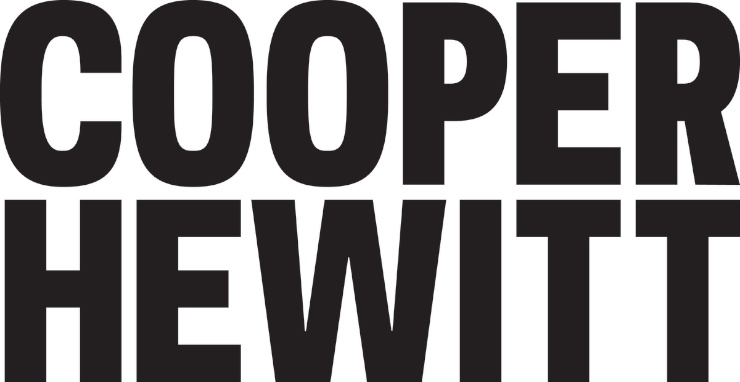

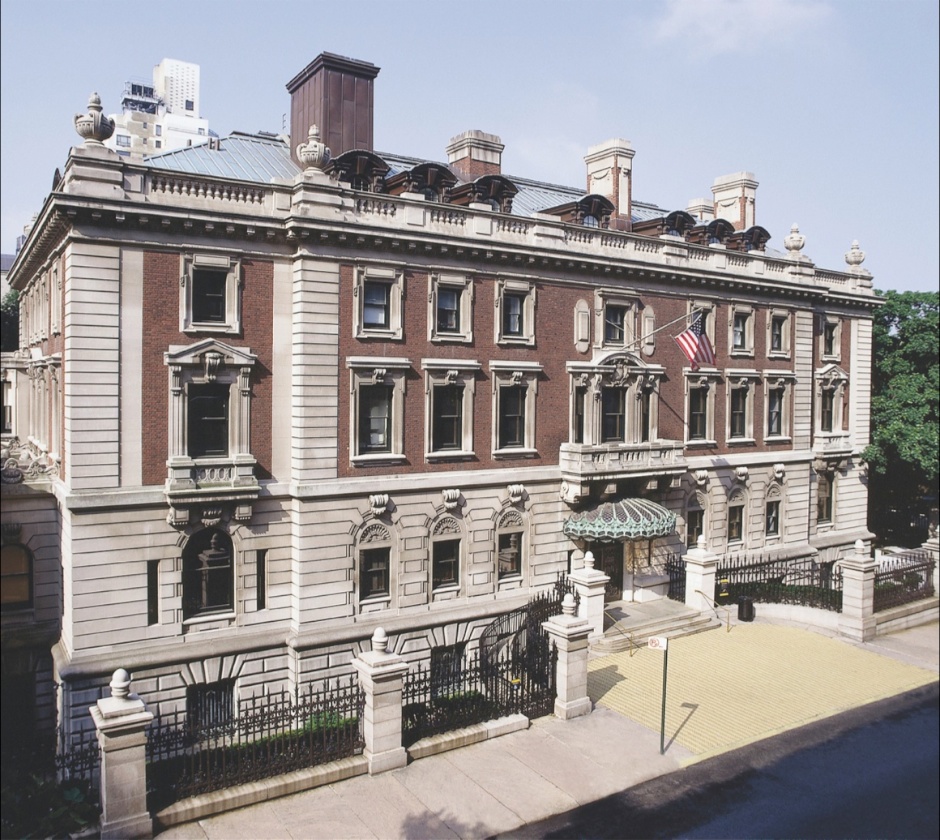 Cooper Hewitt, Smithsonian Design Museum, Mansion exterior. Photo by Matt Flynn © 2012 Cooper Hewitt, Smithsonian Design Museum. COPYRIGHT:Cooper Hewitt.
Cooper Hewitt, Smithsonian Design Museum, Mansion exterior. Photo by Matt Flynn © 2012 Cooper Hewitt, Smithsonian Design Museum. COPYRIGHT:Cooper Hewitt.
Caroline Baumann, director of Cooper Hewitt, Smithsonian Design Museum (formerly Cooper-Hewitt, National Design Museum), has announced plans for the opening of the renovated and restored Carnegie Mansion and the 10 exhibitions that will inaugurate the revamped and expanded gallery spaces.
The nation’s only museum devoted exclusively to historic and contemporary design, Cooper Hewitt will open its doors to the public on Friday, Dec. 12. The museum will boast 60 percent more gallery space to present its important collection and temporary exhibitions and will offer an entirely new and invigorated visitor experience, with interactive, immersive creative technologies.
Cooper Hewitt’s renovation provides the opportunity to redefine today’s museum experience and inspire each visitor to play designer before, during and after their visit. Visitors will explore the museum’s collections and exhibitions using groundbreaking technologies that inspire learning and experimentation. This new participatory experience is specifically designed to engage all audiences—students, teachers, families, young children, designers and the general public.
All visitors will be given a newly developed interactive Pen to collect and create. They will be able to digitally collect design objects on view, as well as additional objects from the ultra-high-definition interactive tables. Visitors will become designers in their own right by creating their own designs with the Pen. Symbolizing and embodying human creativity, the Pen is a key part of every visitor’s experience. With it, they will be able to record their visit, which can be viewed and shared online and supplemented during future visits.
“Cooper Hewitt’s opening…marks a new chapter for the Smithsonian in New York City,” said Wayne Clough, Secretary of the Smithsonian. “The museum continues to serve the public on a local and global level through innovative education and outreach programs and expanded online collections access.”
The largest initiative in Cooper Hewitt’s history, the renovation and expansion of the entire campus on New York’s Museum Mile—the Carnegie Mansion, Arthur Ross Terrace and Garden and the museum’s two townhouses on East 90th Street—have been achieved through a successful $91 million capital and endowment campaign.
“With four floors of exhibition galleries that can now stay open 12 months of the year, free garden access, extended garden and café hours, an inviting new street entrance and the digitization of our collections, Cooper Hewitt will reach a broader audience and be more accessible than ever before,” said Baumann. “We have created a 21st-century museum that will bring our collections to life and make design even more relevant and exciting to today’s audiences, while continuing to respect the history of this museum and the integrity of the much-treasured Carnegie Mansion.”
In addition to Cooper Hewitt’s physical transformation, the museum now has a new name, graphic identity, website and custom typeface. Formally the “Cooper-Hewitt, National Design Museum,” the museum has been renamed “Cooper Hewitt, Smithsonian Design Museum,” emphasizing the museum’s heritage. The museum has taken on a bold new graphic identity designed by Pentagram and the typeface “Cooper Hewitt” designed by Chester Jenkins of Village.
————————————-
OPENING EXHIBITS
Friday, December 12, 2014
The inaugural exhibitions will explore virtually every aspect of design, invite visitors to participate in the design process and present more than 700 objects, from the humble and ubiquitous (eight different patented models of the wooden clothespin) to the complex forms and vivid colors rendered in Michael Eden’s 3-D-printed urn. All visitors will be equipped with an interactive Pen to digitally collect objects on view, as well as additional collection objects via interactive tables, and create their own designs. They will be able to record their visit, which can be viewed and shared online and supplemented during future visits.
“Design is everywhere and this is our moment to communicate this message like never before,” said Caroline Baumann, director of the museum. “The December opening of the re-imagined Cooper Hewitt will mark the moment when this museum becomes an unprecedented international center and public advocate for the best in design. As the nation’s only museum devoted exclusively to historic and contemporary design, we have always played a unique role in America’s cultural life. These inaugural exhibitions demonstrate the many ways we will be able to educate, inspire and empower people through design at the new Cooper Hewitt. Cooper Hewitt will be a place of experimentation, positive change and a place to explain design and bring the design process to life.”
“Through the groundbreaking new visitor experience, expanded presentations of our rich collection and dynamic temporary exhibitions, design stories will truly come alive at the new Cooper Hewitt,” said Barbara Mandel, Cooper Hewitt board chair. “From top to bottom, inside and out, the entire museum has been transformed to encourage visitors to engage in the design process and imagine, create and learn by doing. I cannot wait to welcome visitors to the new museum later this year.”
————————————————–
On View in the New Cooper Hewitt
Floor by floor, the 10 inaugural exhibitions at Cooper Hewitt will prompt and answer key questions at the heart of design.
• On the ground floor, Designing the New Cooper Hewitt will reveal the process behind nearly three years of renovation and transformation at the museum.
• On the first floor, a hands-on Process Lab will emphasize how design is a way of thinking, planning and problem solving, and provide a foundation for the rest of the design concepts on view in the museum.
• Beautiful Users will premiere in the new Design Process Galleries, which will introduce visitors to the shift toward user-centric design based on observations of human anatomy and behavior.
• The guest-curated Maira Kalman Selects will assemble objects from Cooper Hewitt and other Smithsonian collections, as well as the artist’s own home to suggest a life story, from birth through death.
• On the second floor, Making Design will bring together more than 350 objects for the museum’s first long-term survey of works from its collection; Hewitt Sisters Collect will be the first exhibition to share the story of Eleanor and Sarah Hewitt, who in 1897 established a museum within Cooper Union modeled on the Musée des Arts Décoratifs in Paris and the V&A in London; Passion for the Exotic: Lockwood de Forest, Frederic Church will evoke the fascination of late 19th-century America with the arts of India; Models & Prototypes will provide insights into the important role of architectural models and design prototypes.
• The new Immersion Room will feature Cooper Hewitt’s extraordinary collection of wall coverings, allowing visitors to select their favorites—or create their own designs with the Pen—and then project them onto the walls surrounding them at full scale.
 Rendering of the Tools: Extending Our Reach exhibition. COPYRIGHT:Thinc.
Rendering of the Tools: Extending Our Reach exhibition. COPYRIGHT:Thinc.
• On the third floor, in the versatile new 6,000-square-foot Barbara and Morton Mandel Design Gallery, Tools: Extending Our Reach will explore how tools extend the human body, senses, capacity and action—with results that change the world, and also change ourselves. The museum itself is a grand design object, as shown in the ground-floor exhibition Designing the New Cooper Hewitt. Design briefs, sketches, photographs, blueprints and other illustrations from the team of designers will reveal the process behind nearly three years of renovation and transformation at Cooper Hewitt. In the dynamic and interactive Process Lab, visitors will brainstorm design solutions through hands-on and digital activities. It will emphasize how design is a way of thinking, planning and problem solving, and provide a foundation for the rest of the design concepts on view in the museum.
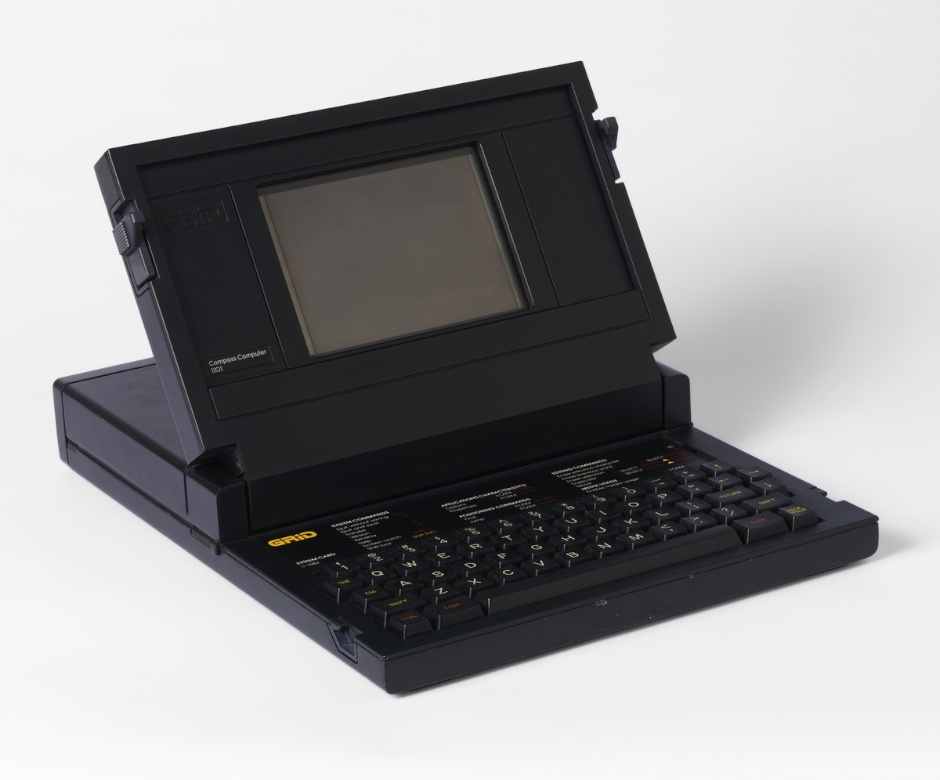
GRiD compass laptop computer prototype, 1981; Designed by Bill Moggridge (English, 1943–2012); Manufactured by GRiD Systems Corporation (USA); Die cast magnesium, injection molded plastic; 25.4 x 29.2 x 37.9 cm (10 x 11 1/2 x 14 15/16 in.); Gift of Bill Moggridge, 2010-22-1; Cooper Hewitt, Smithsonian Design Museum; Photo: Matt Flynn © Smithsonian Institution. COPYRIGHT: Cooper Hewitt, Smithsonian Design Museum.
Beautiful Users—installed in Cooper Hewitt’s gracious first-floor, will introduce visitors to one of the fundamental changes in design thinking over the past half-century: the shift toward designs based on observations of human anatomy and behavior. Beginning with insights of the mid-20th century industrial designer Henry Dreyfuss at Bell Labs, the exhibition will show how definitions of the “normal” person have become more inclusive over the past decades; how designers have come to think of their subjects as users rather than consumers; and how the users are now acting as designers themselves through phenomena such as 3-D printing and “Ikea hacking.” Among the 120 objects in the exhibition will be a screen that features the visitor’s own body in comparison to objects in the collection; examples of the Humanscale measurement system developed by Alvin R. Tilley and Niels Diffrient, which aids in design for children, the elderly, the differently abled and people of diverse height; ergonomically designed objects ranging from Dreyfuss’ Princess telephone and Honeywell Round thermostat to Amos Winter’s Leveraged Freedom wheelchair; a bin of touch samples of various types of handles (labeled “Please Handle”); and multiple prototypes of design objects, showing how designers refine their work through learning how people will use it. Beautiful Users is dedicated to the memory of Bill Moggridge, a pioneer of human-centered design who designed the first laptop computer (the GriD Compass, included in the exhibition) and who was the director of Cooper Hewitt from 2010 to 2012.
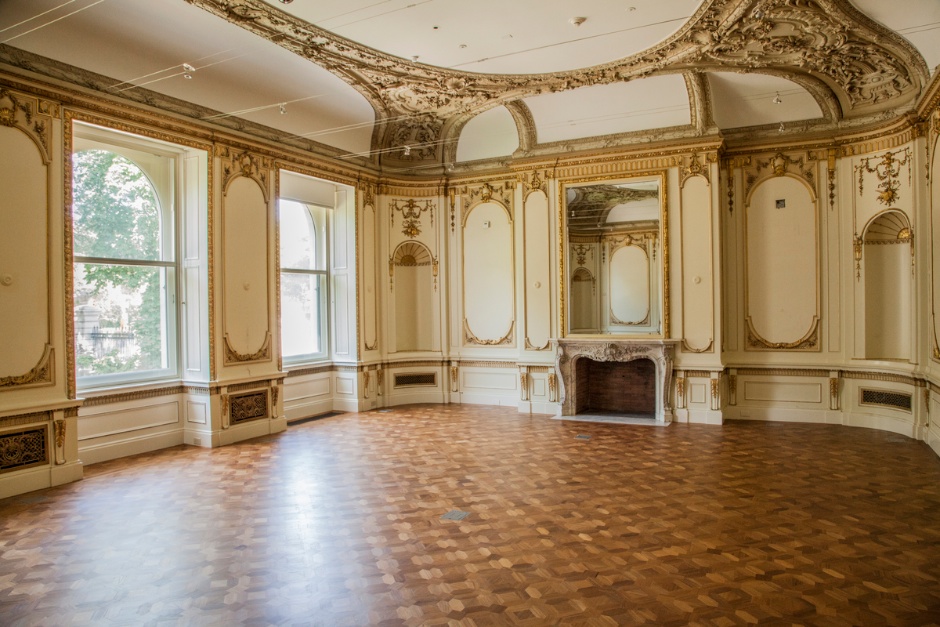 Cooper Hewitt, Smithsonian Design Museum, Nancy and Edwin Marks Gallery (former Music Room). Photo by James Rudnick © 2014 Cooper Hewitt, Smithsonian Design Museum. COPYRIGHT: ©James Rudnick 2012.
Cooper Hewitt, Smithsonian Design Museum, Nancy and Edwin Marks Gallery (former Music Room). Photo by James Rudnick © 2014 Cooper Hewitt, Smithsonian Design Museum. COPYRIGHT: ©James Rudnick 2012.
Maira Kalman Selects will fill the former first-floor Music Room of the Carnegie Mansion with an exhibition curated by author, artist and designer Maira Kalman. Among the works on view will be teapots, illustrated books (Alice in Wonderland and Winnie the Pooh), porcelain figures of ballet dancers, paintings made by Kalman of lamps in the Cooper Hewitt collection, a selection of 19th-century mourning samplers and the funeral pall of President Abraham Lincoln and his gold pocket watch, which was returned to working order for this exhibition.
 Abraham Lincoln’s watch, England, ca. 1858; Gold, glass, metal; Watch: 5.08 x 7.62 x 1.27 cm (2 x 3 x 1/2 in.), watch chain: 33.02 cm (13 in.); Gift of Lincoln Isham, great-grandson of Abraham Lincoln, 219098.1; Courtesy of National Museum of American History, Smithsonian Institution; © Smithsonian Institution. COPYRIGHT:National Museum of American History, Smithsonian Institution.
Abraham Lincoln’s watch, England, ca. 1858; Gold, glass, metal; Watch: 5.08 x 7.62 x 1.27 cm (2 x 3 x 1/2 in.), watch chain: 33.02 cm (13 in.); Gift of Lincoln Isham, great-grandson of Abraham Lincoln, 219098.1; Courtesy of National Museum of American History, Smithsonian Institution; © Smithsonian Institution. COPYRIGHT:National Museum of American History, Smithsonian Institution.
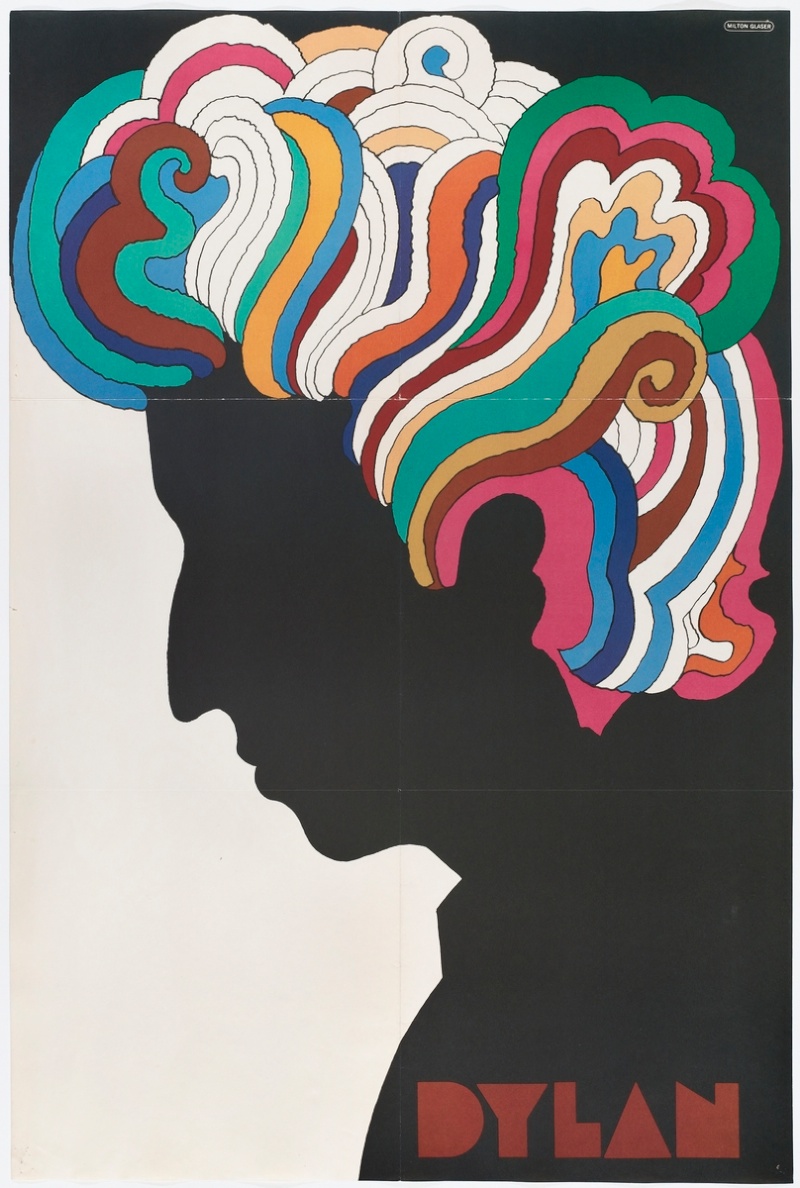 Poster, Dylan, 1966; Milton Glaser (American, b. 1929); Lithograph on paper; 84 x 55.9 cm (33 1/16 x 22 in.); Gift of Richard Kusack, 2007-24-1; Cooper Hewitt, Smithsonian Design Museum; Photo by Matt Flynn © Smithsonian Institution. COPYRIGHT: Cooper Hewitt, Smithsonian Design Museum.
Poster, Dylan, 1966; Milton Glaser (American, b. 1929); Lithograph on paper; 84 x 55.9 cm (33 1/16 x 22 in.); Gift of Richard Kusack, 2007-24-1; Cooper Hewitt, Smithsonian Design Museum; Photo by Matt Flynn © Smithsonian Institution. COPYRIGHT: Cooper Hewitt, Smithsonian Design Museum.
Cooper Hewitt has increased the amount of space showcasing its permanent collection five fold, and Making Design, installed in a suite of renovated galleries on the second floor, is the first in a number of collection exhibitions. Bringing together more than 350 objects, including furniture, lighting fixtures, tableware, clothing, jewelry, books and posters, the exhibition will provide an overview of five key elements of design: color
(red, for this initial installation), form, line, pattern and texture. The red of Jonathan Ive’s design for the iPod Nano compared with the red of the Campana Brothers’s Vermelha chair upholstered in cotton rope, the undulating form of an Alvar Aalto glass vase compared with Tinker Hatfield’s contoured sole for the Nike Air Jordan sneaker, the water pattern of a late 19th-century Japanese fabric compared with the wavy pattern of Bob Dylan’s hair in a 1966 poster by Milton Glaser are a few of the juxtapositions that will introduce visitors to the fundamentals of design through a provocative, visual feast of extraordinary objects.
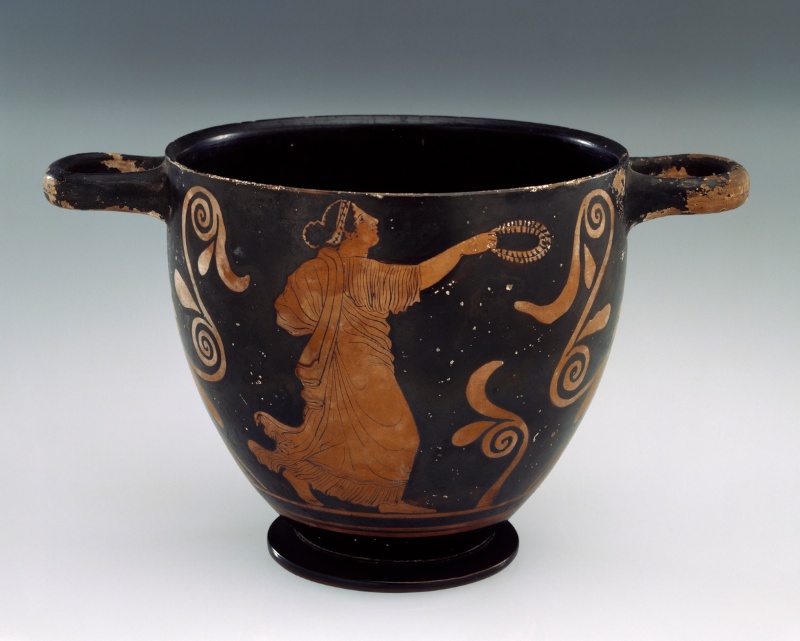 Drinking cup (skyphos), Italy, 5th century BC; Slip painted red figured terracotta; 14 x 16.8 x 25.1cm (5 1/2 x 6 5/8 x 9 7/8 in.); Gift of Charles W. Gould, 1915-11-31; Cooper Hewitt, Smithsonian Design Museum; Photo by Eric Baum © Smithsonian Institution.
Drinking cup (skyphos), Italy, 5th century BC; Slip painted red figured terracotta; 14 x 16.8 x 25.1cm (5 1/2 x 6 5/8 x 9 7/8 in.); Gift of Charles W. Gould, 1915-11-31; Cooper Hewitt, Smithsonian Design Museum; Photo by Eric Baum © Smithsonian Institution.
Hewitt Sisters Collect, the first exhibition to share the remarkable story of Eleanor and Sarah Hewitt, will recognize their central role in the museum’s founding and genesis of the core collection. The museum, originally part of the Cooper Union for the Advancement of Science and Art, was conceived as “a practical working laboratory,” where students and designers could be inspired by actual objects. Even by today’s standards, the Hewitt sisters’ 1897 vision for a museum and collection “for anyone who wanted to use it as a place to work and learn” seems radical. In the galleries that were formerly the Carnegie’s bedrooms, the Hewitts’ contributions and collecting philosophy will be celebrated with objects they gave to the museum or that were acquired under their auspices. Among the 108 objects on view will be antique Greek vessels from the fifth and sixth centuries B.C., French and Italian master drawings and prints of architectural elements and scenes, objects of Meissen porcelain and Wedgwood stoneware, a selection of 18th- and 19th-century architectural birdcages, tapestry and embroidery fragments, and a selection of block-printed wallpapers spanning some 150 years.
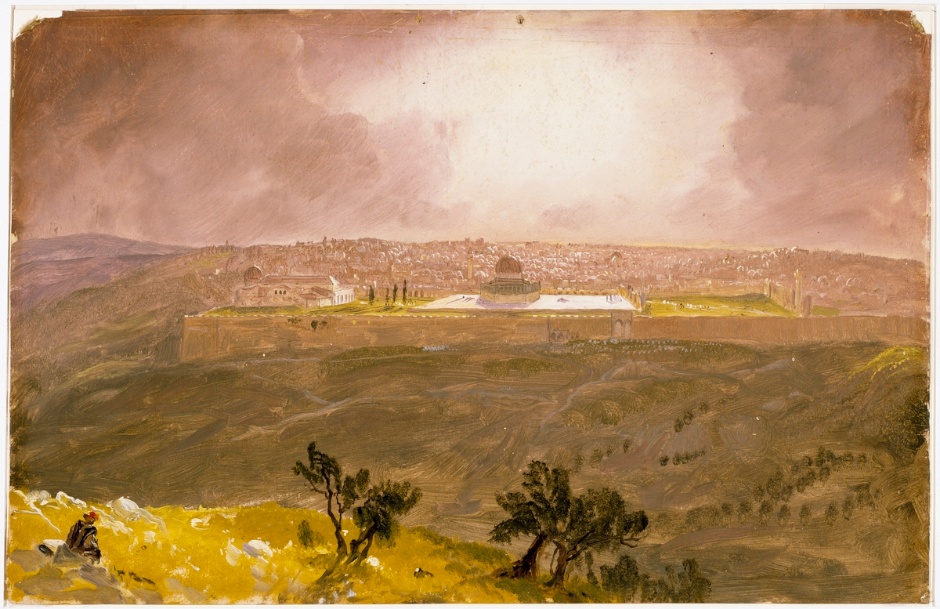 Oil sketch, Jerusalem from the Mount of Olives, 1868; Frederic Church (American, 1826-1900); Brush and oil paint, graphite on cardboard; 30 x 47 cm (11 13/16 x 18 1/2 in.); Gift of Louis P. Church, 1917-4-341; Cooper Hewitt, Smithsonian Design Museum; Photo by Matt Flynn © Smithsonian Institution. COPYRIGHT: Cooper Hewitt, Smithsonian Design Museum.
Oil sketch, Jerusalem from the Mount of Olives, 1868; Frederic Church (American, 1826-1900); Brush and oil paint, graphite on cardboard; 30 x 47 cm (11 13/16 x 18 1/2 in.); Gift of Louis P. Church, 1917-4-341; Cooper Hewitt, Smithsonian Design Museum; Photo by Matt Flynn © Smithsonian Institution. COPYRIGHT: Cooper Hewitt, Smithsonian Design Museum.
One of the great treasures of the Mansion is the former Carnegie Family Library, on the second floor, created by the leading American exponent of the Aesthetic Movement, Lockwood de Forest. Painstakingly cleaned and preserved as part of the Cooper Hewitt renovation, it is the only extant interior by de Forest still situated in the building for which it was created. Paying homage both to de Forest and to his mentor, the Hudson River School painter Frederic Church, Passion for the Exotic: Lockwood de Forest, Frederic Church will evoke the fascination of late 19th-century America with the arts of India, where the library’s intricate ornamental teak woodwork was carved. Among some two dozen objects on view will be drawings, books, stencils, furniture and carved panels by de Forest, works on paper by Church (including a view of his home, Olana), and objects from the 16th through 19th centuries—such as tilework, a wall hanging, and a silver- inlaid ewer—that originated from the vast region that Church, de Forest and Carnegie would have called the East.
 Staircase model, France, late 18th century; Joined, bent and carved pear, wrought brass wire; 75 x 67.3 x 67 cm (29 1/2 x 26 1/2 x 26 3/8 in.); Gift of Eugene V. and Clare E. Thaw, 2007-45-11; Cooper Hewitt, Smithsonian Design Museum; Photo by James Hart © Smithsonian Institution. COPYRIGHT: Cooper Hewitt, Smithsonian Design Museum.
Staircase model, France, late 18th century; Joined, bent and carved pear, wrought brass wire; 75 x 67.3 x 67 cm (29 1/2 x 26 1/2 x 26 3/8 in.); Gift of Eugene V. and Clare E. Thaw, 2007-45-11; Cooper Hewitt, Smithsonian Design Museum; Photo by James Hart © Smithsonian Institution. COPYRIGHT: Cooper Hewitt, Smithsonian Design Museum.
 Staircase model, Paris, France, late 19th century; Carved, bent, joined and veneered cherry and walnut; 31 x 13 x 17.2 cm (12 3/16 x 5 1/8 x 6 3/4 in.); Gift of Eugene V. and Clare E. Thaw, 2007-45-8; Cooper Hewitt, Smithsonian Design Museum; Photo by James Hart © Smithsonian Institution. COPYRIGHT: Cooper Hewitt, Smithsonian Design Museum.
Staircase model, Paris, France, late 19th century; Carved, bent, joined and veneered cherry and walnut; 31 x 13 x 17.2 cm (12 3/16 x 5 1/8 x 6 3/4 in.); Gift of Eugene V. and Clare E. Thaw, 2007-45-8; Cooper Hewitt, Smithsonian Design Museum; Photo by James Hart © Smithsonian Institution. COPYRIGHT: Cooper Hewitt, Smithsonian Design Museum.
 Pulpit model, France, mid-19th century; Carved, joined and veneered walnut, pear, oak; 70 x 40.6 x 33 cm (27 9/16 x 16 x 13 in.); Gift of Eugene V. and Clare E. Thaw, 2007-45-13; Cooper Hewitt, Smithsonian Design Museum; Photo by Ali Elai © Smithsonian Institution. COPYRIGHT: Cooper Hewitt, Smithsonian Design Museum.
Pulpit model, France, mid-19th century; Carved, joined and veneered walnut, pear, oak; 70 x 40.6 x 33 cm (27 9/16 x 16 x 13 in.); Gift of Eugene V. and Clare E. Thaw, 2007-45-13; Cooper Hewitt, Smithsonian Design Museum; Photo by Ali Elai © Smithsonian Institution. COPYRIGHT: Cooper Hewitt, Smithsonian Design Museum.
The second floor of Cooper Hewitt will also feature a Models & Prototypes Gallery, where rotating installations will provide insights into their important role in the design process. For the inaugural installation, the gallery will showcase the exceptional models of staircases donated to Cooper Hewitt by Eugene V. and Clare E. Thaw. Ranging in height from 6 inches to 4 feet, and dating from the late 18th to the early 20th century, the 16 models (and four accompanying drawings) display the structure and design for staircases in pulpits, bell towers, church domes, department stores and private homes. They also serve to document the European tradition of design instruction, with examples of models made by aspiring and established master craftsmen.
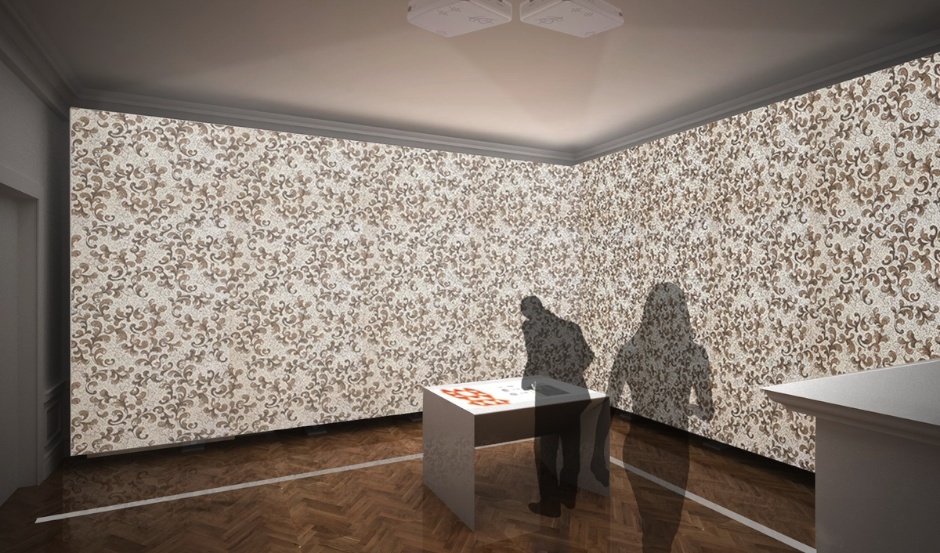 Cooper Hewitt, Smithsonian, Design Museum, rendering of the Immersion Room. Designed for Cooper Hewitt by Diller, Scofidio + Renfro and Local Projects. COPYRIGHT: Cooper Hewitt.
Cooper Hewitt, Smithsonian, Design Museum, rendering of the Immersion Room. Designed for Cooper Hewitt by Diller, Scofidio + Renfro and Local Projects. COPYRIGHT: Cooper Hewitt.
Cooper Hewitt’s extraordinary collection of wall coverings will be featured in a new high-tech space, the Immersion Room, offering visitors the unprecedented experience of using the Pen to select digital images of wallpapers or sketch their own design and then project them onto the walls at full scale to see their impact. More than an entertaining interactive experience, the Immersion Room will give museum visitors their first opportunity to discover Cooper Hewitt’s wall coverings as they were intended to be installed.
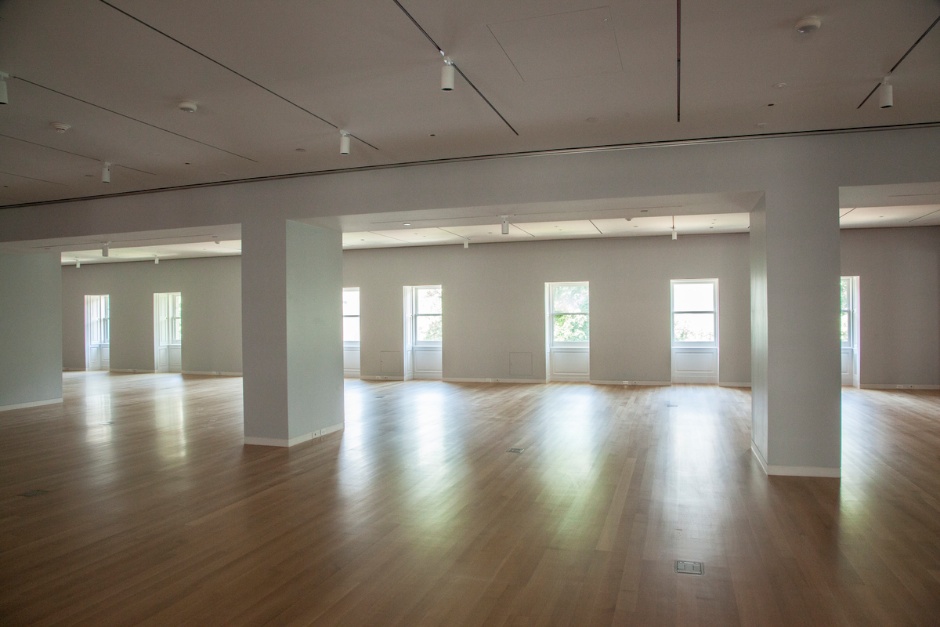 Cooper Hewitt, Smithsonian Design Museum, Barbara and Morton Mandel Design Gallery (third floor). Photo by James Rudnick © 2014 Cooper Hewitt, Smithsonian Design Museum. COPYRIGHT: ©James Rudnick 2012.
Cooper Hewitt, Smithsonian Design Museum, Barbara and Morton Mandel Design Gallery (third floor). Photo by James Rudnick © 2014 Cooper Hewitt, Smithsonian Design Museum. COPYRIGHT: ©James Rudnick 2012.
The inaugural exhibitions culminate in a new public space on the third floor, offering Cooper Hewitt its first open-plan galleries. The entire 6,000-square-foot space, the Barbara and Morton Mandel Design Gallery, will be filled with the exhibition Tools: Extending Our Reach, presenting approximately 175 objects from Cooper Hewitt and nine other Smithsonian collections: Freer Gallery of Art and the Arthur M. Sackler Gallery, National Air and Space Museum, National Museum of African Art, National Museum of American History, National Museum of Natural History, National Museum of the American Indian, Smithsonian American Art Museum, Harvard-Smithsonian Center for Astrophysics and Smithsonian Libraries. Exploring the congruence of good use and good design, the exhibition will survey how tools extend the human body—augmenting our ordinary grasp and power, extending the limits of our senses, sometimes even serving as substitutes (in the case of prostheses)—while considering how some tools break into lives as radical innovations, whereas many others have remained almost unchanged in form and function for centuries. The exhibition will span 1.85 million years of tool use and design—from a Paleolithic chopper made from volcanic rock, to a live feed of the sun transmitted by an orbiting satellite (with an 8-foot-square image projected onto the gallery wall). Other highlights of the exhibition will be the prototype drawings for the telescoping shopping cart and the ice-cream scoop; computer chips designed for advanced military use; microscopes and telescopes; and a remote-controlled “robobee” smaller than a 25-cent piece.
 Solar Wall, 2010; Dr. Mark Weber (American, b. 1969) and Dr. Henry “Trae” Winter III (American, b. 1972); Video display of sun’s surface from the Atmospheric Imaging Assembly aboard NASA’s Solar Dynamics Observatory (SDO); Satellite launch date: February 11, 2010; Courtesy of Harvard-Smithsonian Center for Astrophysics (CfA); Photo by Clive Grainger © 2012. COPYRIGHT:Clive Grainger copyright 2012.
Solar Wall, 2010; Dr. Mark Weber (American, b. 1969) and Dr. Henry “Trae” Winter III (American, b. 1972); Video display of sun’s surface from the Atmospheric Imaging Assembly aboard NASA’s Solar Dynamics Observatory (SDO); Satellite launch date: February 11, 2010; Courtesy of Harvard-Smithsonian Center for Astrophysics (CfA); Photo by Clive Grainger © 2012. COPYRIGHT:Clive Grainger copyright 2012.
————————————————–
Related Publications
Tools, Beautiful Users and Maira Kalman Selects will be accompanied by fully illustrated catalogs. Other reopening publications include Making Design: Cooper Hewitt, Smithsonian Design Museum Collection; Life of a Mansion: The Story of Cooper Hewitt, Smithsonian Design Museum; Ah-Ha to Zig-Zag: 31 Objects from Cooper Hewitt, Smithsonian Design Museum and My Favorite Things. All titles published by Cooper Hewitt will be available in hard copy and e-book versions for all e-book readers.
Tools: Extending Our Reach (published by Cooper Hewitt) features more than 200 images and authoritative essays celebrating human ingenuity across cultures and over time.
Beautiful Users (co-published by Cooper Hewitt and Princeton Architectural Press) by Ellen Lupton explores the changing relationship between designers and users and considers a range of design methodologies and practices, from user research to hacking, open source and the maker culture.
Making Design (published by Cooper Hewitt), the first Cooper Hewitt collection handbook to be produced since 1997, is designed by Irma Boom as a roadmap to explore the museum’s collection. Intended as a design object itself, the publication will be a lasting resource for museum visitors and the public as well as for design students, researchers, scholars and professional designers. It will provide an in-depth understanding of design processes and the museum’s extraordinary holdings relative to design ideas today.
Life of a Mansion: The Story of Cooper Hewitt, Smithsonian Design Museum (published by Cooper Hewitt) by Heather Ewing is the history of the Carnegie Mansion and of Cooper Hewitt. Illustrated with 200 photographs, maps, floor plans and letters, the book chronicles the 110-year history of the National Landmark building and the evolution of the museum from its establishment by the Hewitt Sisters in 1897 to its status post- renovation in 2014 as the nation’s design authority.
Ah-Ha to Zig-Zag: 31 Objects from Cooper Hewitt, Smithsonian Design Museum (published by Cooper Hewitt; Distributed by Skira/Rizzoli) by Kalman is an unconven- tional alphabet book for children of all ages that uses a variety of collection objects to look at design concepts. Objects ranging from a 13th-century silk thinking cap to Gerrit Rietveld’s Zig-Zag chair are brought to colorful life, accompanied by Kalman’s whimsical hand-lettered text.
My Favorite Things (published by HarperCollins) features more than 50 original paintings of objects from both the Cooper Hewitt and Kalman’s personal collections. A pictorial index provides photographs of the actual objects and a short description.
————————————————–
Sponsors
Beautiful Users is made possible by major support from the Adobe Foundation. Additional funding is provided by Amita and Purnendu Chatterjee, the August Heckscher Exhibition Fund, the Ehrenkranz Fund, the Bill Moggridge Memorial Fund, The Richard H. Driehaus Foundation, Deborah Buck, May and Samuel Rudin Family Foundation Inc. and IDEO.
Maira Kalman Selects is made possible by the Marks Family Foundation Endowment Fund. In-kind support is provided by Maharam.
Exhibitions of the permanent collection are made possible by major support from Nancy Marks. Additional support is provided by the Henry Luce Foundation.
Hewitt Sisters Collect is made possible by generous support from Nancy Marks. Additional funding is provided by Margery and Edgar Masinter and Smithsonian Women’s Committee.
Passion for the Exotic: Lockwood de Forest, Frederic Church is made possible in part by the American Express Foundation. Restoration of the Teak Room is supported in part by the American Express Historic Preservation Fund.
Tools: Extending Our Reach is made possible by major support from GE. Generous support is also provided by Newell Rubbermaid and Esme Usdan. Additional funding is provided by the August Heckscher Exhibition Fund, the Ehrenkranz Fund, and Smithsonian Institution funds from the Grand Challenges Consortia.
————————————————–
Cooper Hewitt, Smithsonian Design Museum
Founded in 1897, Cooper Hewitt is the only museum in the nation devoted exclusively to historic and contemporary design. The museum educates, inspires and empowers people through design, presenting compelling educational programs, exhibitions and publi- cations. International in scope and possessing one of the most diverse and comprehensive collections of design works in existence, the museum’s rich holdings range from Egypt’s Late Period/New Kingdom (1100 B.C.) to the present day and total more than 210,000 objects.
Cooper Hewitt is located at 2 East 91st Street at Fifth Avenue in New York City. Hours are Sunday through Friday, 10 a.m. to 6 p.m. Saturday, 10 a.m. to 9 p.m. The cafe and garden open two hours prior to the museum. The museum is closed on Thanksgiving Day, Christmas Day and New Year’s Day. Public transit routes include the Lexington Avenue 4, 5 and 6 subways (86th or 96th Street stations) and the Fifth and Madison Avenue buses. General admission, $18; senior citizens and college students, $12. Cooper Hewitt members and children younger than age 18 are admitted free. Pay What You Wish, every Saturday, 6 to 9 p.m. The museum is fully accessible.
For further information, please call (212) 849-8400, visit Cooper Hewitt’s new website at www.cooperhewitt.org
————————————————–
ARCHITECTURAL FACT SHEET
Project Description
Cooper Hewitt, Smithsonian Design Museum has renovated its home, the Carnegie Mansion on New York City’s Museum Mile, to transform a grand early-20th-century residence into a 21st-century museum. The nation’s only museum devoted exclusively to historic and contemporary design, Cooper Hewitt will now have 60 percent more gallery space to present its important collection and temporary exhibitions and will offer an entirely new and invigorated visitor experience, with interactive, immersive creative technologies.
The transformation of the Carnegie Mansion respects the spirit and character of the landmark building, restoring key elements to the original grandeur while providing much- needed upgrades to lighting and signage, more flexibility to reduce installation time and better accommodate object handling and above all enhanced public access on every level.
Through reprogramming of portions of the mansion and the adjacent townhouses, as well as reconfiguring conservation and collection-storage facilities, the project will increase the museum’s total exhibition space from approximately 10,000 square feet to 17,000 square feet, including the 6,000-square-foot gallery on the third floor, which has never before been used for public exhibitions.
Leadership
Caroline Baumann, Director; Barbara A. Mandel, Chairman, Board of Trustees; and Beth Comstock, President, Board of Trustees
Original Carnegie Mansion Architect
Babb, Cook & Willard (completed 1902)
Architects
Gluckman Mayner Architects, New York;
Beyer Blinder Belle Architects & Planners LLP, New York;
Diller Scofidio + Renfro, New York
Landscape Architect
Hood Design, Oakland, CA
Project Cost
$91 million project includes $81 million renovation/expansion and $10 million endowment
————————————————–
MAJOR FEATURES
Original Design Features
Built for the family of Andrew Carnegie, the Carnegie Mansion was the first private residence in the United States to have a structural steel frame and one of the first in New York to have a residential Otis passenger elevator (now in the collection of the Smithsonian’s National Museum of American History in Washington, D.C.). Other innovations were the inclusion of central heating and a precursor to air-conditioning. In the cellar a pair of enormous twin boilers were fed by coal transferred from storage bin to furnace by a coal car that traveled over a miniature railroad track.
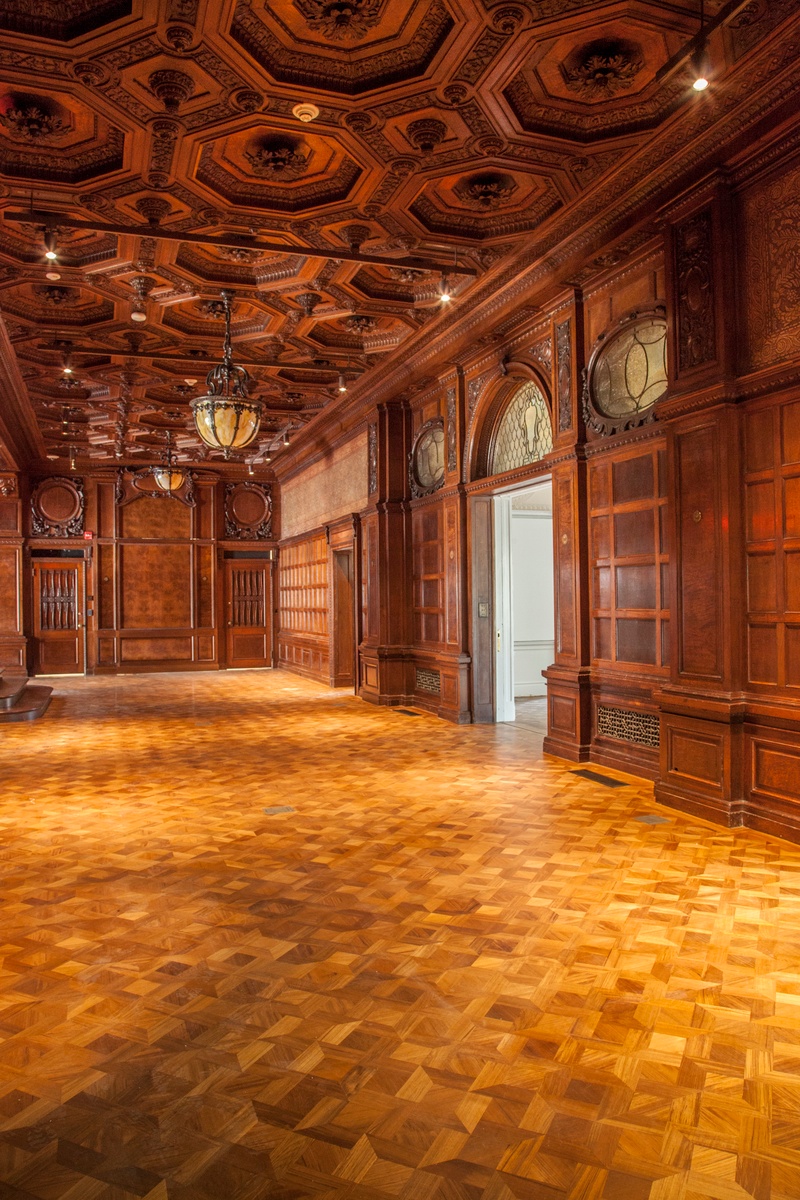 Cooper Hewitt, Smithsonian Design Museum, Great Hall. Photo by James Rudnick © 2014 Cooper Hewitt, Smithsonian Design Museum. COPYRIGHT:©James Rudnick 2012.
Cooper Hewitt, Smithsonian Design Museum, Great Hall. Photo by James Rudnick © 2014 Cooper Hewitt, Smithsonian Design Museum. COPYRIGHT:©James Rudnick 2012.
Historic Preservation and Modernization
The integration of new mechanical/electrical systems, fire egress stairs, ADA accessible routes and fire detection and sprinklers were carefully integrated into this National Historic Landmark. A Historic Structures Report and a Preservation Plan were generated by Beyer Blinder Belle to inform work and, aided by materials conservation studies, the Great Hall and Stairs, the Teak Room and other significant spaces on the first two floors were meticulously restored. Historic spaces were documented and representative finishes and details were saved as part of the important historic record.
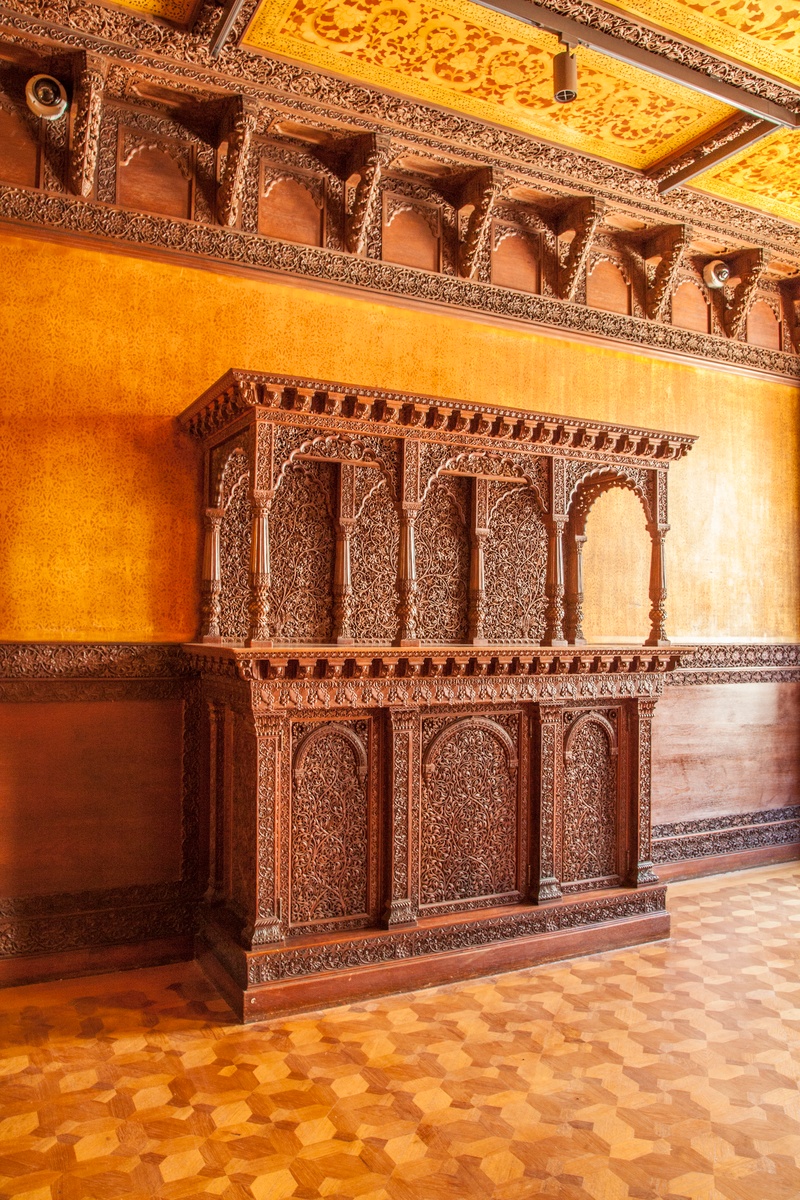 Cooper Hewitt, Smithsonian Design Museum, Teak Room, designed by Lockwood de Forest for the Carnegie family. Photo by James Rudnick © 2014 Cooper Hewitt, Smithsonian Design Museum. COPYRIGHT:©James Rudnick 2012.
Cooper Hewitt, Smithsonian Design Museum, Teak Room, designed by Lockwood de Forest for the Carnegie family. Photo by James Rudnick © 2014 Cooper Hewitt, Smithsonian Design Museum. COPYRIGHT:©James Rudnick 2012.
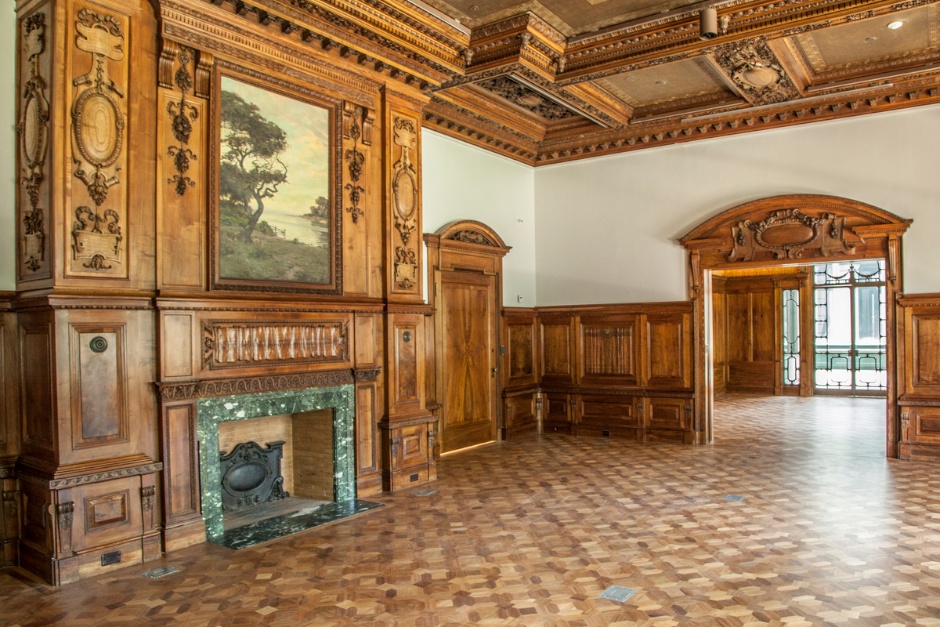 Cooper Hewitt, Smithsonian Design Museum, Enid and Lester Morse Gallery (former Dining Room). Photo by James Rudnick © 2014 Cooper Hewitt, Smithsonian Design Museum. COPYRIGHT:©James Rudnick 2012.
Cooper Hewitt, Smithsonian Design Museum, Enid and Lester Morse Gallery (former Dining Room). Photo by James Rudnick © 2014 Cooper Hewitt, Smithsonian Design Museum. COPYRIGHT:©James Rudnick 2012.
Exterior
The project included cleaning and repair of exterior masonry and the historic wrought-iron fence.
New Entrances
A thorough refurbishment of the 91st Street foyer has removed a dozen layers of paint to reveal magnificent Caen stone, restoring the graciousness of the main entrance to the mansion. The new public entrance on 90th Street creates a heightened street presence for the museum.
Galleries
First-floor galleries have been restored to provide improved spaces for an interactive introduction to design.
Second-floor galleries have been expanded by converting existing office space to provide more room to showcase the museum’s collection and temporary exhibitions.
There is a new 6,000-square-foot gallery on the third floor, which has never before been used for public exhibitions.
Garden & Terrace
Hood Design is evolving the original Richard Schermerhorn, Jr. design from 1901, using durable local New York schist as terrace pavers, garden pathways and in the re-imagined rockery, tying the garden to its larger context of Central Park.
Unique Pivot System
A unique new pivot system of cornices on the third floor preserves historic detailing while accommodating the installation of large design objects. A 2,000 pound “secret” pivot door in the Great Hall conceals back-of-house functions.
Cooper Hewitt, Smithsonian Design Library
The Cooper Hewitt, Smithsonian Design Library was moved from the Mansion to the townhouses at 9 East 90th Street in 2011 as part of Phase One of the renovation project. The new Library includes the Arthur Ross Reading Room; an additional elegant, quiet study room; the Fred and Rae S. Friedman Rare Book Room; reference spaces; a workroom; open stacks; and offices.
Retail & Café Spaces, Other Visitor Amenities
SHOP Cooper Hewitt has been relocated from the Carnegie Library on the western end of the first floor to the eastern end of the first floor , adjacent to the café, creating a new visitor path.
The new SHOP was designed by Diller Scofidio + Renfro, working in collaboration with the museum. A new café was designed by Gluckman Mayner Architects and Beyer Blinder Belle with expanded communal seating, and increased service times. The café will have expanded hours matching the garden, so neighbors and tourists alike can enjoy an early morning cappuccino from 8:00 a.m.
Additional major improvements to the Mansion include expanded public restrooms, a new conservation lab, and conveniently located and enlarged registrar spaces.
Sustainable Features & Mechanical System Improvements
In keeping with Cooper Hewitt’s public mission of design, the building project is seeking LEED Silver certification from the Leadership in Energy and Environmental Design green- building rating system. LEED achievements include:
• Recycling and/or salvaging 75% of construction waste and creating a construction waste management plan
• Optimizing energy performance by 10.5% – 14%
• Purchasing green-e-certified electricity supply for 2 years, for 35% of the
building’s electricity demand
• Reducing water use by 40%
Not visible but crucial to the project were the careful integration of many mechanical system improvements including: lighting, air conditioning, plumbing, electrical, fire protection, security and data infrastructure throughout the building, as well as the discreet introduction of fire sprinklers throughout the Mansion’s main floors.
Dimensions & Figures
Exhibition Space … 17,000 square feet.
Education Space … 3,146 square feet.
SHOP Cooper Hewitt … 1,450 square feet.
The Arthur Ross Terrace & Garden … 7,600 square feet.
Café … 600 square feet.
——————————————————-
2 East 91st Street, New York City
www.cooperhewitt.org
——————
Visit these AAQ Museum Architecture Portfolios (links)
Glenstone, Potomac, Maryland / 2006 – 2008
Harvard Art Museums, Cambridge / 2014
MAD — Museum of Arts and Design, NYC / 2016
Parrish Art Museum, Water Mill, NY / 2012
The Clark Institute of Art, Berkshires / 2014
The Morgan Library & Museum, NYC / 2006
Wadsworth Atheneum Museum of Art, Hartford / 2017
Whitney Museum of American Art, NYC / 2015
Yale University Art Gallery, New Haven / 2012
_______________________________________________

